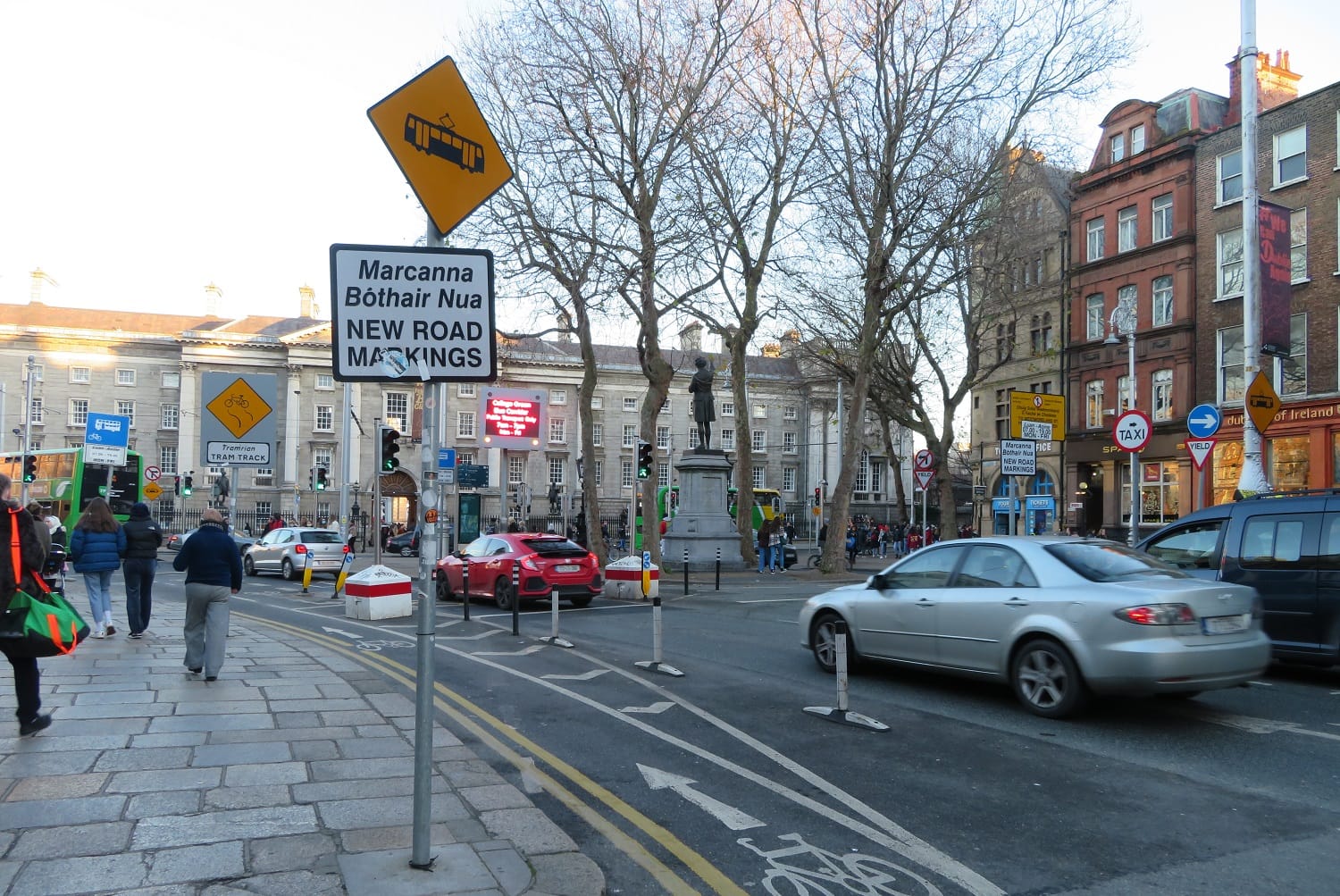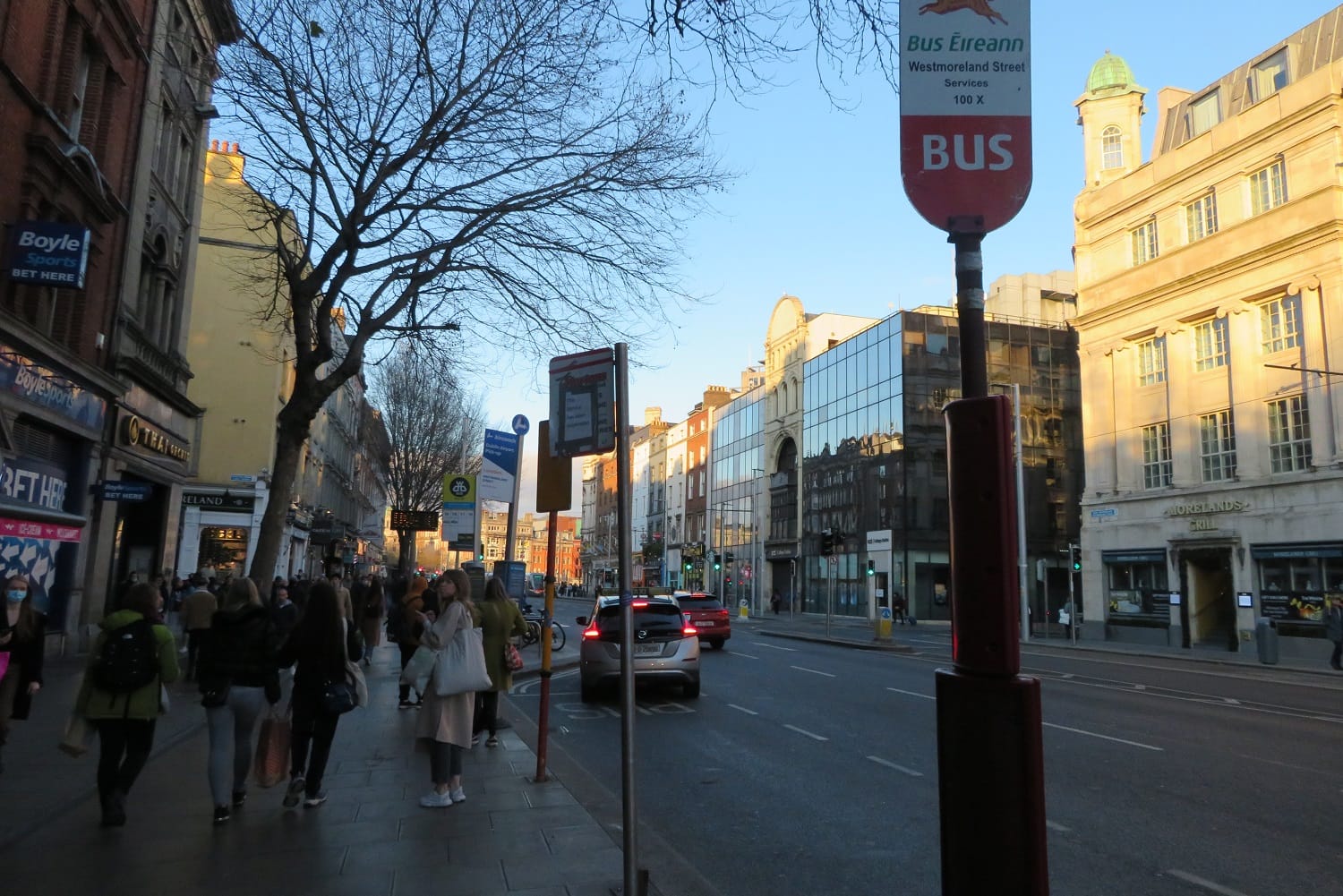What’s the best way to tell area residents about plans for a new asylum shelter nearby?
The government should tell communities directly about plans for new asylum shelters, some activists and politicians say.
The council intends to carry out a wider culling of street clutter too, according to the new draft city development plan. But the last plan said that too.

At College Green, a glut of signs tell pedestrians, cyclists and motorists where to go and what to do.
There are stop signs, taxi signs, parking signs, arrows to indicate the direction of traffic, a bicycle sign, Luas signs, a sign that says there are new road markings, signs about the bus lane, a different yellow sign about the Westmoreland Street bus lane.
And a large screen that switches between the speed limit and information about the bus lane.
From lampposts hang banners for the council’s We Can Dublin Again campaign, and sat in the middle of an island, almost hidden by signs, trees and street furniture is a large map of the city, together with signs giving pedestrians directions.
“It’s bewildering,” says Labour Party Councillor Joe Costello. “If we continue to have such clutter of signage, we effectively have no signage because you can’t see anything.”
At a meeting of Dublin City Council’s Central Area Committee on Tuesday 14 December, Costello put forward a motion calling on the council to tackle street clutter in one small part of the city.
He found a small corner in Stoneybatter beset by the same problem as College Green, street clutter. Costello counted 10 objects, including a disused postbox.
Councillors on the committee agreed to that and to push for a pilot programme to tackle street clutter in the council’s Central Area, which covers not just Stoneybatter but parts of the northside from the Phoenix Park to the Docklands and from the river back to Glasnevin.
The pilot could suggest a way forward for the city, they said.
Near a “Welcome to Stoneybatter” sign on the junction of Manor Street and Shea’s Court, the spot Costello had honed in on for his motion, the Labour councillor had counted seven objects together “within a 1-metre radius” and three more nearby.
As well as the welcome sign, there is a parking meter, a lamppost with a sign about not feeding birds, a disused post box, a 50kmph sign, a bus-lane sign and a pay-and-display sign.
When Costello tabled his photo there were another two poles and a planter on the other side of the path, but on Tuesday there were five planters in front of the mural there bringing the total number of items on that corner to 14.
Rubbish is regularly dumped on that corner, said Costello and the clutter of objects “detract from the overall streetscape”.
Councillors on the Central Area Committee unanimously agreed Costello’s motion calling on the public domain officer to remove unnecessary objects from that corner.
And Fine Gael Councillor Ray McAdam, who chairs the committee, said he will sit down with council officials to work out a pilot project to de-clutter (some of) the streets in the area.
“If that is successful then we can look to go to the wider council to get a plan across the city,” he said.

The problem of street clutter has worsened in recent times, said Costello on the phone on Tuesday. “It’s a pressing issue because so much has happened since Covid.”
The city is in the process of changing, to allow for more walking and cycling infrastructure, as well as new bus routes, he says.
But with every change comes even more signage. “We need to rationalise it and streamline it across the city,” he says.
Social Democrats Councillor Cat O’Driscoll said at the meeting that the council should write to An Post and ask it to remove any of its infrastructure in the area that is not in use.
As well as disused post boxes, An Post has storage boxes in some places that also contribute to street clutter, said Green Party Councillor Janet Horner on the phone on Monday.
“We have an objective in the [last] development plan regarding the reduction of clutter,” said Horner at the meeting.
But it appears that the objective “has been largely carried over” to the new city development plan without having been completed, she said.
The last city development plan committed to carry out an audit and remove 20 percent of redundant signage and poles.
And “to seek the multiple uses of poles for road and directional signage including butterfly bike locking”, it said.
The new draft plan commits to carry out an audit and remove redundant signage and to “investigate measures to promote co-sharing and integration with other street furniture elements”.
Horner, the Green Party councillor, got a response from the council’s chief executive, Owen Keegan, in November 2020to say that the council had identified 653 vacant sign poles and removed 316 of them, and the work was still ongoing.
But in practice, street clutter appears to be increasing, says Horner.
Costello, the Labour councillor, says the council is legally obliged under traffic laws to put up certain signs.
“Some of it is mandatory,” he says. “We are going to have to go back then and look at the legislation.”
The council needs to carry out a survey of the city, a full street-clutter audit, as it has committed to do in the development plan, and then issue a report, says Costello.
On Westmoreland Street, opposite the Westin Hotel, there is a row of seven signs perched high on separate poles.
There is a sign with an arrow to direct drivers towards car parks and a no parking sign.
There are five signs marking the stops for different bus operators, all on individual poles: Bus Éireann, Mortons Coaches (currently suspended), the Big Red Bus, the Aircoach, and Dublin Bus.

No one is suggesting that the bus signs should be removed, says Horner, but they could be clustered together on just two poles.
The council needs to communicate and co-operate with other public bodies, including Dublin Bus and the National Transport Authority, she says.
At the moment, each agency only seems concerned with putting up the signs, she says. “Everyone has their own thing and they just don’t think it’s their responsibility to look at the whole picture.”
She has been told that some signs cannot be amalgamated under the current legislation she says.
“Signage structures should be rationalised,” says the Design Manual for Urban Roads and Streets, a guidance document from the Department of Transport.
“Individual sign poles may be better utilised and signs should be clustered together on a single pole,” it says.
But the Traffic Signs Manual, also published by the Department of Transport, says the opposite. “Signs supported by a single post should be used where possible,” it says.
However it also says: “In urban areas, the obstruction caused by posts located in narrow pedestrian footways should be minimised.”
Every effort should be made to ensure poles don’t impede movement for wheelchair users, vision-impaired people and the elderly, it says.
The pavements in the city are so cluttered that it’s like an obstacle course for disabled people, says Horner.
Horner says council officials told her they cannot attach new 30kmph speed-limit signs to existing poles nearby because they are too big. (Some speed limit signs are already combined with other signs, though.)
Horner says it would reduce street clutter if the whole of the city centre had a 30kmph speed limit. Signs wouldn’t be needed on every street then, she says.
Get our latest headlines in one of them, and recommendations for things to do in Dublin in the other.